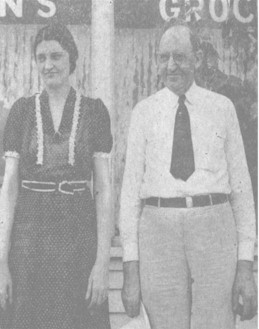|
||||
| Had
Ringside Seat at Show
Thursday, July 20, 1939 - Old Hickory News - 15th Anniversary |
||||
Mule Power Popular "There were lots of mules around here," Mr. Robinson recalls today. "The government had four camps of them and the largest camp had 4,000 animals in it." Mule power was absolutely essential in getting any work done, according to Mr. Robinson. "The only roads around here for a long time were sand." he says. "After a rain they packed down pretty good, but the rest of the time it was tough to get through. Then, if it was a plain old dirt road, wet weather was terrible and we didn't have any automobiles out here very much before the war." Ferry Boat Service Where today hundreds of people pass over the Old Hickory bridge without much throughout as to time and hazard improvement, there was once when getting from one side of the river to the other was a real problem. "Why, I can remember when there wasn't anything but a little old boat powered by oars," Mr. Robinson chuckled. "Then they got a gasoline motored ferry. "And there was even a time when the boat you were on was pulled across by a wire."A temporary pontoon bridge girded the river early in the Powder Plant days, and this was followed by the famous suspension bridge which allowed one way traffic. Suspension Way-Laid This bridge was originally ordered and constructed for use in South America. In its dismantled state, it was being shipped there from up east, but when the emergency arose here, the government held up the shipment and had the bridge put up over the Cumberland. This was down at the end of the old concrete road which runs beyond the "Cellophane" plant and which is today gradually being narrowed by the free growing trees and bushes on either side. This stretch of pavement is a "dead end" road today and few cars are seen there.In 1928 the present bridge was dedicated, opening a suitable outlet to the Gallatin Road and Nashville. Note: The concrete road is still visible today. See the interesting article following this article. The First Rumor One of Mr. Robinson's strongest recollections is of his first intimation that "something awfully big was going to happen to Hadley's Bend." "I was plowing in a field down there off the road by the river," he mused. "Two men came along and asked a lot of questions and wanted to know if I'd sell. But they didn't tell a thing." "They just wanted to find out a lot about here. I think they finally took 60-day options on everybody's property. Then in about a month they came back. One of them was Daniel Cauffield. "That time he told us that he was working for the government but that the du Pont Company had first figured on the property. He was getting one dollar a year acting as real estate agent."There were lots of rumors and plenty of talk. Then they took up the options pretty soon, and that's when the scramble started."People began coming from all directions and all sorts of buildings went up. Yes, it was a mighty interesting time." "Miss Maud" Like her father, "Miss Maud", as she is familiarly known to young and old, has a very vivid picture of the coming of the Powder Plant and all its attendant upheaval.It is a memory of swarming activity and confusion, of mass everything. The days of water melons, cattle and corn fast disappeared once the actual work started on the world's largest smokeless powder plant. "It was a case of everybody rushing around busy and not knowing what it was all about, either," she says. "It was plenty of fun, though, and certainly made a big change out here," she concluded.
From: Tennessee Concrete - Summer 1990 - Volume 4, NO. 2 A 1919 publication described Old Hickory as "....not a temporary village, but a permanent, modern city." Since the city was to be permanent, so too were the streets and roads to be permanent. Most of the streets and roads, both heavy industrial and residential, were built with concrete. Several of these streets survive today - - 72 years later - - and are still in use. Unfortunately, most of the streets were blacktopped in 1988, after 71 years of continued service, but some, such as Plant Service Road, on the cover, are still in use and have not yet been maintained. Yes, they have suffered from wear and tear, but 72 years of cost-free service is not to be discounted. In reality, a 4"' whitetop (bonded overlay) would probably give another 70 years of service. As it is, the plant can now expect to be spending money for backtopping every seven to ten years. The conclusion which must be drawn from these and other concrete roads is simply that cheap, first cost is not the answer. In today's market, concrete can compete with asphalt on a first-cost basis if equal structures are required. Unfortunately, concrete is seldom treated equally and cities are paying a devastating cost for annual maintenance and blacktopping.
|
||||



